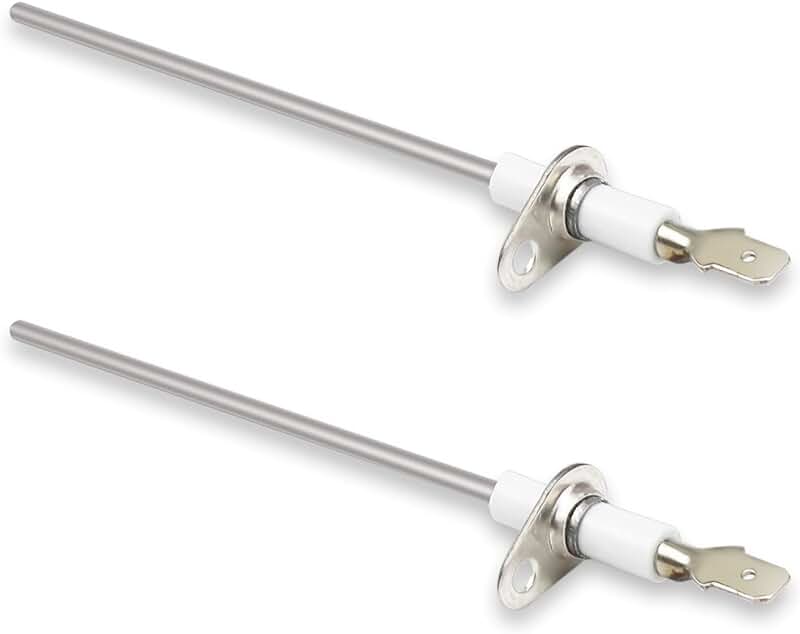Detecting a Flame to Ensure Safety & Efficiency
Your furnace's flame sensor is a little part, but it does a big job of keeping your heating system safe and working well. It checks if there's a flame in your furnace and makes sure it stays lit. If this sensor doesn't work, your furnace might not start, or it could even be dangerous. To make sure your furnace is safe and works right, you need to take care of the flame sensor. You should regularly check it, clean it, and test it to find and fix any problems. If you don't do this, your furnace might start and stop a lot, have trouble igniting, or the flame might go out completely.
Understanding the Flame Sensor
The flame sensor is like the detective of your furnace. It's in charge of figuring out if there's a flame burning. To do its job, it uses electricity to sense the flame. If it doesn't find a flame, it tells the furnace to stop the gas so things stay safe. Keeping the flame sensor in good shape means checking it and cleaning it to get rid of any stuff that might get in the way.
Signs of a Dirty or Faulty Flame Sensor
A dirty or messed-up flame sensor can cause different problems with your furnace. One common sign is your furnace turning on and off a lot. This happens when the flame sensor can't spot the flame correctly. So, it shuts things down too soon. You might also notice a delay before your furnace starts. It's like a click before the fire comes on. This can be because the flame sensor is covered in dirt or rust and has trouble finding the flame. And if your furnace just won't light up at all, that's a clear sign the flame sensor isn't working right. Ignoring these signs is not a good idea because a messed-up flame sensor can make your furnace less safe and less efficient.
1. Frequent Cycles
If your furnace keeps turning on and off all the time, it might be because the flame sensor is acting up. When the flame sensor doesn't do its job right, it can't tell if there's a flame, so the furnace stops too soon. This constant starting and stopping is not just annoying. It can also make your furnace wear out faster and cost you more on your energy bill.
2. Delayed Ignition
If you've ever heard your furnace making a clicking noise before it starts, it's a problem called delayed ignition. This happens because the flame sensor is having a tough time spotting the flame due to dirt or rust. When the flame sensor isn't doing its job well, your furnace takes longer to get going.
3. Flame Outage
If your furnace just won't start at all and there's no flame, that's a big sign your flame sensor is not working right. This is not just frustrating; it can be dangerous because a lack of flame might mean gas is building up in your home.
4. Error Codes
Error codes can be like little clues from your furnace, helping you figure out what's wrong with the flame sensor. When the sensor senses a problem, it usually talks to you through an error code on the furnace's control board. These codes can tell you if there's a bad connection or if the sensor needs a good cleaning. Understanding these error codes is super helpful because they point you in the right direction to fix the flame sensor.
5. Visible Debris
A common problem that can mess up your furnace flame sensor is when it gets covered in dirt and dust. As time goes by, all these little particles can stick to the sensor and stop it from seeing the flame properly. When it's dirty like this, the sensor might send the wrong signals to the control board, causing issues like the furnace turning on and off a lot or starting slowly.

Flame Sensor Maintenance
Taking care of your furnace's flame sensor is important to keep your heat running smoothly and safely. Especially in the cold weather. First, you should know that there are two main things you need to do: repair and maintenance. Repair means fixing any problems that pop up, while maintenance is all about stopping problems from happening.
So, for regular maintenance, you want to check if your flame sensor looks worn out or damaged. Look for things like rust or stuff that might be blocking it. If you find any issues, take care of them right away to prevent bigger troubles later. Another crucial part is cleaning the flame sensor. It can get covered in dirt and dust over time, which can make it hard for it to see the flame. So, make sure to clean it up and keep it free from anything that might get in its way.
Safety First
Safety always comes first when you're dealing with your furnace flame sensor. Furnaces involve gas and electricity. So, it's crucial to be careful to avoid accidents or injuries. Here's what you should do before you start working on your flame sensor. Turn off the power to your furnace and shut off the gas supply. This stops accidental fires or electric shocks from happening.
Accessing the Flame Sensor
To get to your furnace's flame sensor, you need to follow some steps. The process might differ based on your furnace's type and model, but here are some general guidelines to help you out. It's usually close to the burner assembly. To reach it, you might have to take off the furnace panel or access door. For specific instructions, check your furnace's manual.
Once you've got to the sensor, carefully take it out of its housing. Usually, it's held in place with screws or mounting brackets. Pay attention to how it's positioned before you remove it because you'll need to put it back correctly later.

Cleaning the Flame Sensor
Now that you've reached the flame sensor, it's time to give it a good cleaning. This is a really important step to keep it working well. Over time, it can get covered in dirt and dust, and that messes up its ability to spot the flame properly. This can lead to problems like your furnace not working right or not working at all.
To clean the flame sensor, here's what you'll need: a soft cloth or a brush and some rubbing alcohol. Be gentle as you wipe off any dirt or junk from the sensor. Don't press too hard, or you might damage it.
Inspecting the Flame Sensor
After you've accessed and cleaned your furnace flame sensor, the next important step is to inspect it to make sure it's working properly. This is a crucial part of keeping your furnace running efficiently and safely.
Start by looking at the sensor for any signs of wear or damage. Check if there are any cracks, breaks, or issues with the sensor itself or the wires connected to it. Also, see if there are any loose or corroded connections. If you spot problems, don't wait—address them promptly to prevent further damage or potential breakdowns. Next, check the area around the sensor for any signs of debris or blockages. Make sure there's no dirt, dust, or soot building up that might mess with the sensor's performance. Clean up anything that could be in the way, and make sure the area around the sensor is clean and safe.
While you're doing the inspection, pay attention to any strange smells or sounds coming from your furnace. These could be signs of an issue with the flame sensor or some other part of the furnace. If you notice odd odors or hear unusual noises, it's better to contact a professional HVAC technician for further checks and repairs.
Reassembling and Testing
After cleaning your furnace flame sensor, it's time to put it back together and do some testing. Here's what you need to do:
Carefully place the sensor back into its housing, making sure to align it properly as per the notes you took when you removed it. Secure the sensor in place using screws or mounting brackets.
If the sensor is working. Turn on the power to your furnace and wait for it to start up. Watch the flame and make sure it stays steady and blue. If the flame is yellow or flickering, that could be a sign that there's still an issue with the sensor. If that's the case, it's best to get in touch with a professional HVAC technician for further checks and repairs.
By reassembling and testing your furnace flame sensor, you can make sure it's back where it should be and doing its job correctly. This is a really important step in keeping your furnace efficient and safe.
Regular Maintenance
Keeping up with regular maintenance is the secret to making sure your furnace flame sensor works well for a long time. When you have a maintenance plan in place, you can spot problems early and avoid pricey repairs or replacements later on.




















